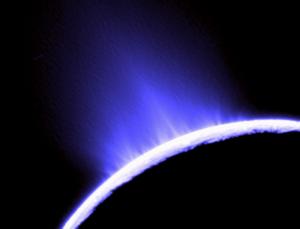NASA’s Cassini probe has made its deepest dive to date into the plumes spewing from Saturn’s moon Enceladus (Image: Cassini Imaging Team/SSI/JPL/ESA/NASA)
03 November 2009 by Rachel Courtland
NASA’s Cassini spacecraft made its deepest plunge yet into the plumes of Saturn’s moon Enceladus on Monday. The dive might reveal complex organic molecules that could hint at life.
Researchers have been fascinated with Enceladus since July 2005, when Cassini revealed plumes of ice particles and water vapour shooting out from the moon’s south pole.
The origin of the plumes is still being debated. But evidence is mounting that the moon may have liquid water beneath its surface, a potential habitat for life.
Until now, Cassini has maintained a cautious distance from the densest part of the plumes, flying at distances of 260 kilometres or more from the surface. But mission members changed that policy after they determined that ice grains would not pose a threat to the spacecraft if it made a slow, close approach of the plume’s central regions.
Hunting for the unexpected
They used the tug of Saturn’s biggest moon, Titan, to steer Cassini onto a path that on Monday took it into the plumes just 100 km above Enceladus’s south pole. There, the plumes emanate from long fissures called tiger stripes.
What will the spacecraft find?….
We highly reccommend New Scientist magazine . Click on the link for the complete article.

